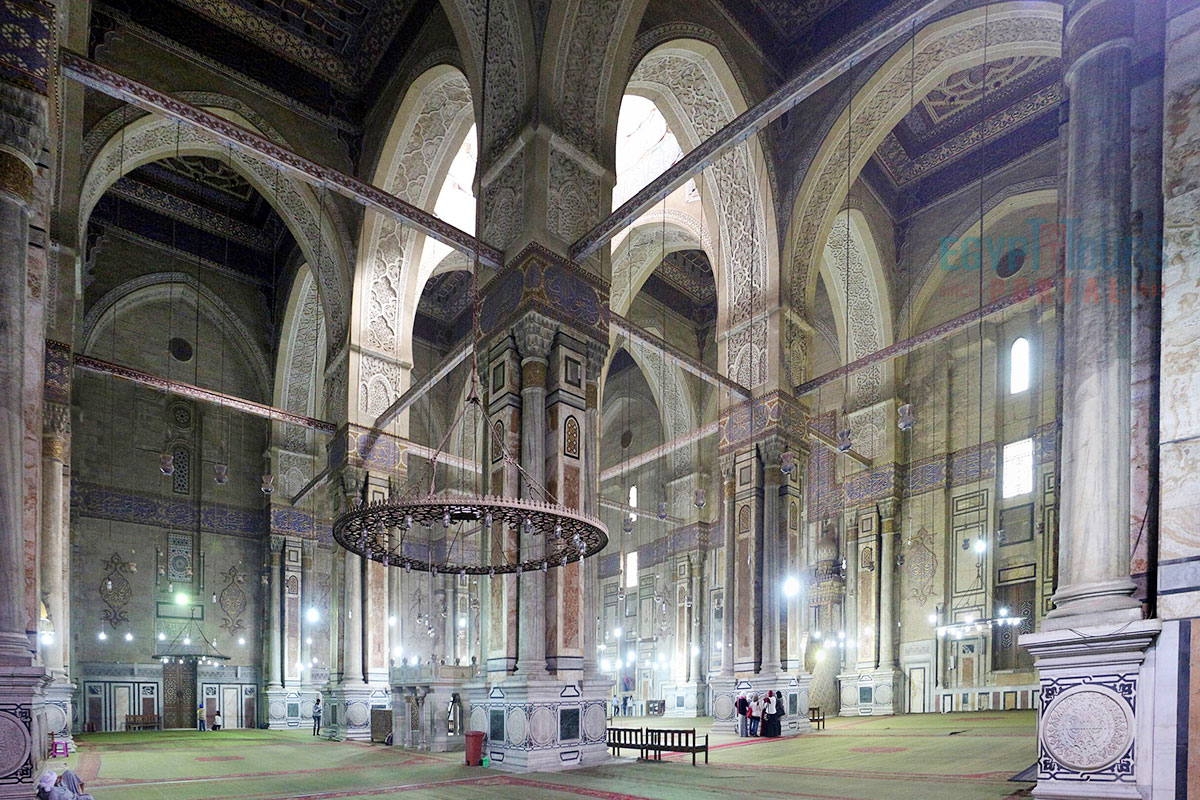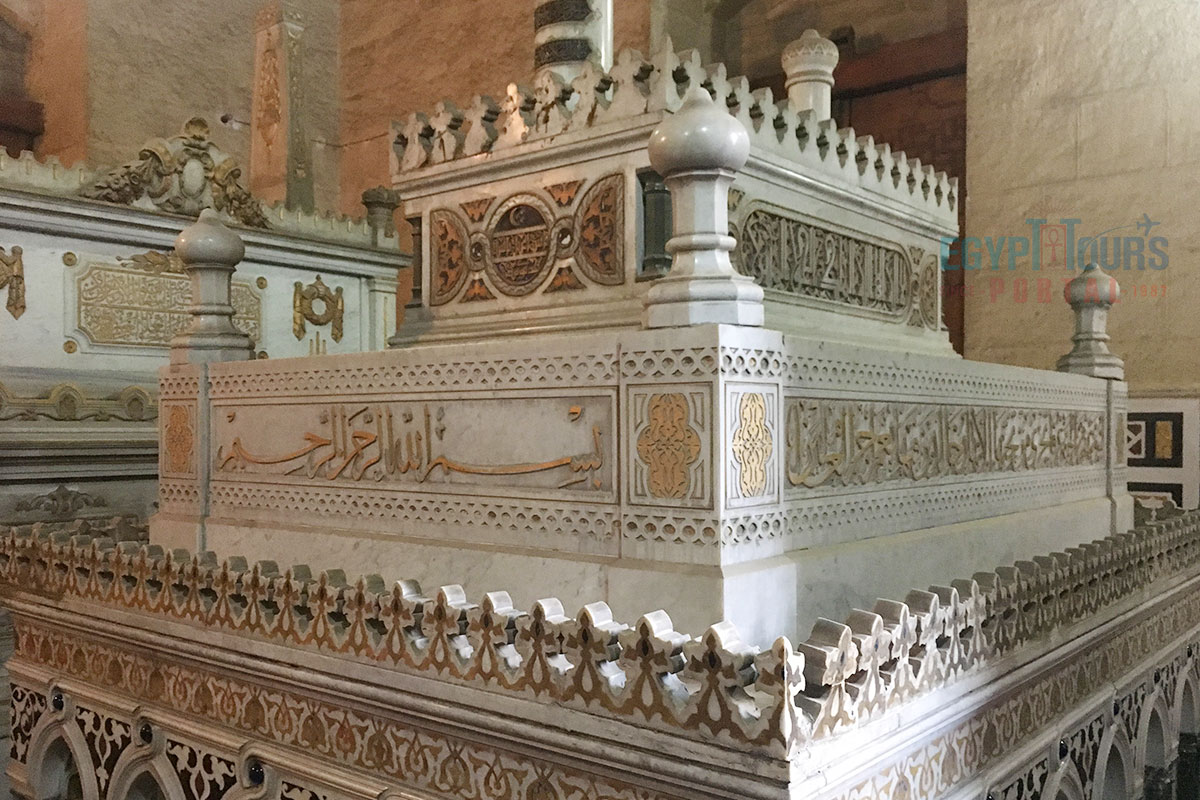The Al-Rifai Mosque was built between 1869 and 1912 as a prominent example of neo-Mamluk architecture. It was commissioned by Queen Khushyar Hanim, it replaced the small zawiya of Al-Rifai and serves as both a mosque and a royal mausoleum, housing figures like Khedive Ismail and King Farouk. Despite delays during construction, it was completed with the help of architects such as Max Herz. Located near Cairo’s Citadel and Sultan Hassan Mosque, it stands as a symbol of Egypt's architectural and royal heritage, featuring grand domes, minarets, and a beautifully ornate mausoleum.

Al-Rifai Mosque is one of the most majestic constructions in Egypt. It’s located in "Midan al-Qal’a" in Cairo, next to the Cairo Citadel and opposite the Mosque of Sultan Hassan. It’s known in English as the Royal Mosque, as the mosque was constructed at the order of Queen Khushyar Hanim, the mother of Khedive Isma’il Pasha, in 1869 A.D., to replace the zawiya of al-Rifai (a small mosque) with a massive mosque resembling the Mosque of Sultan Hassan in magnitude and height. It was designed to become a prayer house and a mausoleum for the royal family, "The Descendants of Mohammad Ali".

The Al-Rifai Mosque, covering 6,500 square meters, was constructed in two main phases between 1869 and 1912. The site originally held a small 12th-century Fatimid-era mosque, known as the Al-Dakhirah Mosque, which was later converted into a Sufi Zawiya called the Al-Bayda Zawiya.
This Zawiya contained the tombs of two Sufi mystics, Ali Abu Shubbak al-Rifa'i and Yahya al-Ansari. In the late 19th century, Hoshiyar Qadin, mother of Khedive Isma'il Pasha, commissioned the expansion and renovation of the Zawiya to create a larger mosque that would serve as a burial site for the Khedive family. The original structure was mostly demolished, except for the graves of the Sufi mystics.
The construction initially began under architect Hussein Fahri Pasha, a member of the Muhammad Ali dynasty, but halted in 1880 after Khedive Isma'il’s abdication and Hoshiyar Qadin’s death in 1885. In 1905, construction resumed under Khedive Abbas Hilmi II, who appointed Max Herz, the Hungarian architect and head of the Committee for the Conservation of the Monuments of Cairo, to oversee the project.
Herz was assisted by Italian architect Carlo Virgilio Silvagni and advised by Ali Pasha Mubarak, Minister of Public Works under Khedive Isma'il. This collaboration led to the mosque’s completion in 1912, establishing Al-Rifai as one of Egypt’s most significant mosques, blending traditional Islamic elements with European architectural expertise.

The Al Rifai Mosque is located in the heart of the historic district of Islamic Cairo, next to the Saladin Citadel and facing the Sultan Hassan Mosque. The mosque's strategic location makes it a popular stop for tourists exploring Cairo’s religious and historical landmarks. The structure is also close to several cultural attractions, creating a vivid experience of Cairo’s Islamic heritage.

Al-Rifai Mosque consists of two sections, the first section is the house of worship, which consists of the Quibla iwan, which was designed based on a basilican style and contains three Riwaqs circled by four marble piers supporting the pointed arches, while the ceiling was made from golden colored wood decorations. The Mihrab used to be covered with colored marble and golden stalactites and is located in the center of the Qibla wall. In contrast, the Minbar, made of wood and decorated with ebony and ivory, was located on the right side of the mihrab.
The second section is the tombs of the royal family, as the mosque holds three domes, the tombs of Khedive Ismail, his mother, his wives, and his sons and daughters. The mosque also holds the remains of Ismail, King Fouad, Farouk "The Last King of Egypt", and the last Shah of Iran, who was married to one of Farouk’s sisters. The mosque also contains two mausoleums for Sheik Yehia Al-Ansary and Ali Abu-Shebak. The outer side of the Mosque is decorated with two beautiful minarets on both sides of the main entrance.

The mausoleum within Al Rifai Mosque serves as the final resting place for several important figures, including members of the Egyptian royal family, Sufi mystics, and even exiled foreign leaders. The mausoleum houses:
If you are in Cairo and prefer to visit this amazing attraction, then you can check our Egypt tours and book your amazing trip. Or you can enjoy one of our Nile River cruises to discover the best tourist attractions around Egypt.
Cairo Stopover Tour For New Zealander Travelers Cairo stopover tour is the ultimate ...
Tour Location: Cairo/Giza...
Day Tour in Cairo and the Pyramids For New Zealander Travelers Day Tour in Cairo and...
Tour Location: Cairo/Giza...
Day Trip to Pyramids from Cairo for New Zealander Travelers Day trip to the Pyramids...
Tour Location: Giza...
Saqqara & Memphis Tour from Cairo For New Zealander Travelers Saqqara & Memp...
Tour Location: Memphis and Sakkara...
Several notable figures are buried within the Al Rifai Mosque:
King Farouk: The last king of Egypt, whose remains were repatriated after his death in exile.
Khedive Ismail Pasha: An Ottoman ruler and modernizer of Egypt.
Shah Mohammad Reza Pahlavi of Iran: The last Shah of Iran, exiled following the 1979 Iranian Revolution.
Sufi Saint Sheikh Ali Al Rifai: The mosque's namesake and a revered Sufi mystic.
These individuals’ burial in Al Rifai Mosque reflects its significance as a resting place for influential leaders and respected religious figures.
Shah Mohammad Reza Pahlavi of Iran, the last monarch of Iran, is buried in Al Rifai Mosque in Cairo. After his exile from Iran in 1979, he sought refuge in several countries before settling temporarily in Egypt, where he eventually passed away in 1980. The Egyptian government, under President Anwar Sadat, granted him a dignified burial at the Al Rifai Mosque as a symbol of solidarity. His tomb remains a unique feature of the mosque, symbolizing a historical bond between Egypt and Iran.
The entire country of Egypt deserve to be explored with its every heavenly detail but there are places that must be seen before any other such as the breathtaking Hurghada's red sea, The wonders of Cairo the pyramids of Giza, the great sphinx, the Egyptian Museum, Khan El Khalili Bazaar, the wonders of Luxor like Valley of the Kings, Karnak & Hatshepsut temple and the wonders of Aswan such as Abu Simbel temples, Philea temple, Unfinished obelisk and The Wonders of Alexandria like Qaitbat Citadel, Pompey's Pillar and Alexandria Library. Read more about the best places to visit in Egypt.
If you want to apply for a Visa On Arrival that lasts for 30 days then you should be one of the eligible countries, have a valid passport with at least 6 months remaining and pay 25$ USD in cash, as for the E-Visa for 30 day you should have a valid passport for at least 8 months, complete the online application, pay the e-visa fee then print the e-visa to later be presented to the airport border guard. You could also be one of the lucky ones who can obtain a free visa for 90 days. Read more about Egypt travel visa.
Egypt has a variety of delicious cuisines but we recommend “Ful & Ta’meya (Fava Beans and Falafel)”, Mulukhiya, “Koshary”, a traditional Egyptian pasta dish, and Kebab & Kofta, the Egyptian traditional meat dish.
The best time to travel to Egypt is during the winter from September to April as the climate becomes a little tropical accompanied by a magical atmosphere of warm weather with a winter breeze. You will be notified in the week of your trip if the Climate is unsafe and if any changes have been made.
You should pack everything you could ever need in a small bag so you could move easily between your destinations.
We have been creating the finest vacations for more than 20 years around the most majestic destinations in Egypt. Our staff consists of the best operators, guides and drivers who dedicate all of their time & effort to make you have the perfect vacation. All of our tours are customized by Travel, Financial & Time consultants to fit your every possible need during your vacation. It doesn't go without saying that your safety and comfort are our main priority and all of our resources will be directed to provide the finest atmosphere until you return home.
You will feel safe in Egypt as the current atmosphere of the country is quite peaceful after the government took powerful measures like restructuring the entire tourist police to include all the important and tourist attractions in Egypt. Read more about is it safe to travel to Egypt.
Wear whatever feels right and comfortable. It is advised to wear something light and comfortable footwear like a closed-toe shoe to sustain the terrain of Egypt. Put on sun block during your time in Egypt in the summer to protect yourself from the sun.
The best activity is by far boarding a Nile Cruise between Luxor and Aswan or Vise Versa. Witness the beauty of Egypt from a hot balloon or a plane and try all the delicious Egyptian cuisines and drinks plus shopping in old Cairo. Explore the allure and wonders of the red sea in the magical city resorts of Egypt like Hurghada and many more by diving and snorkeling in the marine life or Hurghada. Behold the mesmerizing western desert by a safari trip under the heavenly Egyptian skies.
There are a lot of public holidays in Egypt too many to count either religious or nation, the most important festivals are the holy month of Ramadan which ends with Eid Al Fitr, Christmas and new years eve. Read more about festivals & publich holidays in Egypt.
Egypt is considered to be one of the most liberal Islamic countries but it has become a little bit conservative in the last couple of decades so it is advised to avoid showing your chest, shoulders or legs below the knees.
Arabic is the official language and Most Egyptians, who live in the cities, speak or understand English or at least some English words or phrases. Fewer Egyptians can speak French, Italian, Spanish, and German. Professional tour guides, who work in the tourism sector, are equipped to handle visitors who cannot speak Arabic and they will speak enough English and other languages to fulfill the needs of all our clients.
The fastest way is a car, of course, a taxi. If you are in Cairo ride a white taxi to move faster or you could board the fastest way of transportation in Egypt metro if the roads are in rush hour.
The temperature in Egypt ranges from 37c to 14 c. Summer in Egypt is somehow hot but sometimes it becomes cold at night and winter is cool and mild. The average of low temperatures vary from 9.5 °C in the wintertime to 23 °C in the summertime and the average high temperatures vary from 17 °C in the wintertime to 32 °C in the summertime. The temperature is moderate all along the coasts.
It is the home of everything a traveler might be looking for from amazing historical sites dating to more than 4000 years to enchanting city resorts & beaches. You will live the vacation you deserve as Egypt has everything you could possibly imagine.









